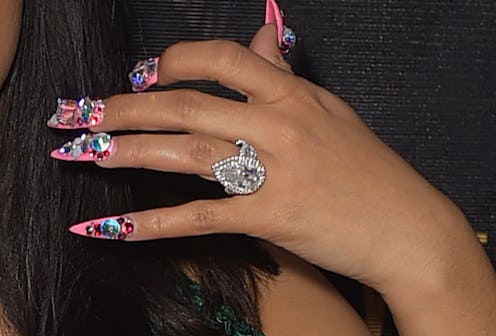
It may be a new year, but whitewashing isn't a thing of the past. It's just days into 2018, and Vogue is being accused of whitewashing "manicure sculptures." Twitter users are accusing the magazine snubbing a long history of intricate manis with roots in black culture in a recent article on the nail "trend." Claiming it was a new trend, Vogue seemingly offended people of color by not recognizing the blinged-out nail art as a style black women have been sporting for ages.
Fans say calling "manicure sculptures" a new and avant-garde trend shows a lack of awareness at best, and an erasure of a whole group of people and culture at worst.
In a tweet on Dec. 29, Vogue announced that "manicure sculptures" are the "most extreme nail art yet," and linked to an article exploring the maximalist designs of a New York nail artist, Sarah Nguyen. While her designs are beautiful and opulent, the article made no mention of how these types of styles have been prevalent for ages in the black community. Which is a glaring omission, black Twitter users say, especially considering how fashion trends are usually written about. For example, when talking about brocade, mentions of the Renaissance are often peppered throughout an article. Anything with fragile lace or high necklines gets thrown back into Victorian England. Empire dresses are almost always linked back to Greek goddesses, and good luck seeing a shoulder pad without some mention of the Dynasty-heavy '80s era.
Fashion publications often highlight where the original inspiration came from, but, as users pointed out, that was not the case with Vogue.
Veering away from cutsey, paint-on nail designs, Nguyen instead creates 3D structures by layering on gemstones and baubles onto long fingernails.
"Nguyen’s world, as chronicled on her Instagram feed, @chrmdbysarah, is a glinting parade of bedazzled bricolage, outré rhinestone designs, and towering, bejeweled creations," Vogue writes.
Which, to be fair, is very true. But, as people of color on Twitter pointed out, it's interesting to see these bedazzled nails written in this kind of way, especially when you consider that when black women wear similar designs, they're deemed as "ghetto" and inappropriate for work or events.
Seeing this gap, Twitter was quick to call out the erasure.
Others were highlighting how the reclassifaction of nail art is just another form of gentrification.
Some users highlighted how borrowing from black culture and making it "new" is, in fact, nothing new. Just look at what happened with trendy "boxer braids."
Others simply wanted there to be an acknowledgement that this "trend" originated in black and brown communities.
Some pointed out that when they're on black hands, the nail art is no longer called "manicure sculptures." Instead, they are looked down upon.
As Revelist reported, one of the best known lovers of "manicure sculptures" is Cardi B, who is famous for her bedazzled nails.
In fact, as Revelist pointed out, Cardi B was asked to tone down her nail aesthetic at the beginning of her fame because it no longer fit with her elevated wealth and success. She even addressed the hate directed toward her "manicure sculptures" in the below Snap.
There's no mention of Cardi B in the Vogue article.
Some people might see this exchange on Twitter and think it's an over-reaction. But it points to an undeniable disconnect in standards of what is "appropriate" for white people and people of color.
According to black Twitter users, the bottom line is simple: Before you claim a style is a new trend, learn its roots. And give credit where credit is due.